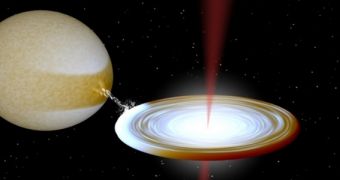Astronomers with the International Center for Radio Astronomy Research in Perth, Australia, led by astrophysicist Roberto Soria, discovered in a new study that the average intensity of radiation winds produced by black holes has been significantly underestimated in previous researches.
The team determined that these dark behemoths batter their stellar neighborhoods with high-intensity winds that are way stronger than initially calculated. This finding may help experts refine their models of black hole evolution, thus providing new insights into the evolution of large galaxies.
The connection between the size of a black hole and the size of its host galaxy has been the subject of many investigations, but a clear answer on this issue has yet to be proposed. What is clear however is that a link exists, and that the two are mutually-deterministic, Space reports.
Black holes are the collapsed nuclei of massive stars at least 8 times heavier than the Sun. They compress millions to billions of solar masses in objects no larger than Earth, resulting in near-infinite density. The extreme gravitational pull they generate does not even allow light to escape into space.
What scientists did know about black holes is that they could not release an amount of radiation exceeding the so-called Eddington limit. Beyond this threshold, the quantity of radiation would push surrounding gas away, essentially starving the dark behemoth.
What experts did not know for sure was whether or not the amount of kinetic energy released by a black hole – either as jets or winds – abides by the same limit. By studying the MQ1 black hole at the core of the Messier 83 (M83) galaxy, the team found that the kinetic energy released was “two to five times higher than the Eddington limit for a black hole of this mass.”
For this study, experts used data from the NASA/ESA Hubble Space Telescope, the NASA Chandra X-ray Observatory, and the Australia Telescope Compact Array. MQ1 lies around 15 million light-years away from Earth, in the constellation Hydra.
“This powerful black hole is in a famous nearby galaxy that has been looked at gazillions of times, but was never spotted or never noticed,” says Soria. He adds that it was only through a combination of images from the three telescopes that MQ1 became visible enough to allow for this type of study.
The study, published in the February 27 online issue of the top journal Science, finally demonstrates that even small black holes can produce huge amounts of kinetic energy, as some experts had speculated. “We have finally shown that even a small one can be so powerful,” the team leader argues.
“In our models, we will have to pay more attention to the huge influence black hole jets have in the evolution of young galaxies, even small black holes that maybe would have been ignored in the past,” Soria concludes.

 14 DAY TRIAL //
14 DAY TRIAL //